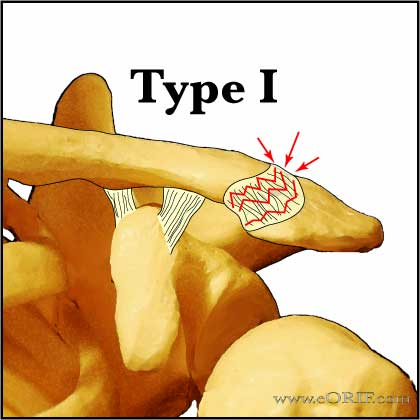 |
Type I
- Strain of acromioclavicular ligaments, ligaments intact, AC joint stable.
- Tenderness/swelling isolated to AC joint, no palpable displacement of joint, minimal pain with arm ROM.
- No xray changes.
- RX: sling/ice/nsaids prn; activity modifications until painfree, symptoms usually subside in 7-10 days.
|
 |
Type II
- Acromioclavicular ligaments disrupted, A/P stability disrupted, superoinferior stability maintained by coracoclavicular ligaments; deltoid/trapezious insertions may be injured slightly.
- Pain/swelling in AC joint; clavicle may be elevated; arm motion causes pain; tenderness in coracoclavicular interspace.
- Xray-lateral clavicle may be elevated, AC joint widened, coracoclavicular interspace maintained.
- RX: sling 7-10 days or until symptoms subside; early gradual rehab; heavy lifting/contact sports avoided 8-12 wks
|
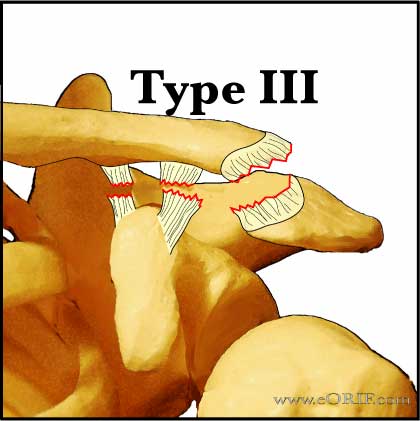 |
Type III
- Acromioclavicular and coracoclavicular ligaments disrupted, deltoid and trapezius insertions disrupted.
- Pain in AC joint and shoulder; clavicle likely visibly elevated, may tent skin; pain with any shoulder ROM; tenderness in coracoclavicular interspace. Lateral clavicle unstable in horizontal and vertical planes.
- Xray: distal clavicle elevated above the superior border of the acromion.
- RX:controversial. Non-operative management is generally recommended. Surgery may be considered for young, athletic individuals, heavy laborers, and those who do overhead work with type III injuries. RX: Acromioclavicular Joint Reconstruction.
|
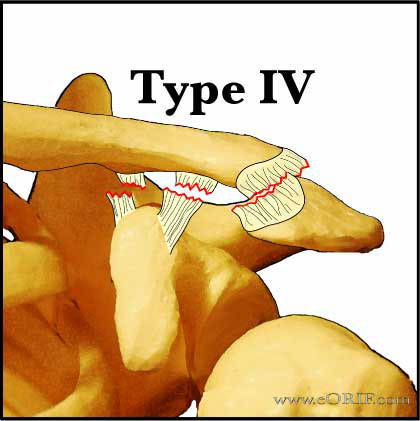 |
Type IV
- Rare; clavicle posteriorly displaced into or through the trapezius; acromioclavicular and coracoclavicular ligaments disrupted, deltoid and trapezius insertions disrupted.
- Lateral clavicle palpable posteriorly, may tent skin, usually very painful, pain with any ROM.
- Xray: distal clavicle displaced posteriorly, best visualized on axillary view.
- RX: Acromioclavicular Joint Reconstruction.
|
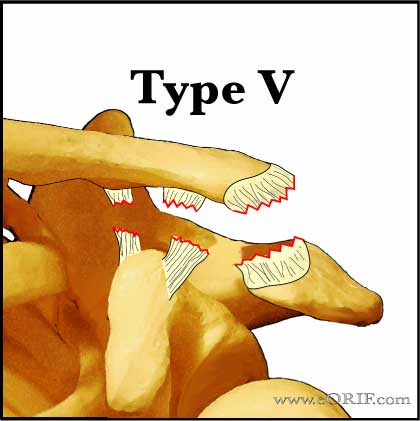 |
Type V
- Acromioclavicular and coracoclavicular ligaments disrupted, deltoid and trapezius insertions disrupted with >100% elevation of the distal clavicle.
- Xray: 100%-300% increase in the coracoclavicular interspace. Average space between coracoid and clavicle is 1.1 to 1.3cm
- RX: Acromioclavicular Joint Reconstruction.
|
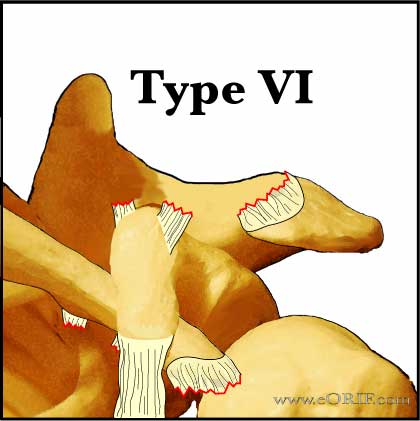 |
Type VI
- Acromioclavicular and coracoclavicular ligaments disrupted with inferior dislocation of the distal clavicle inferior to the coracoid process and posterior to the biceps and coracobrachialis tendons.
- Painfull, limited shoulder motion due to pain. Evaluate for associated brachial plexus injury.
- Xray: distal clavicle displaced inferior to coracoid process as seen on Znace or A/P view
- RX: Acromioclavicular Joint Reconstruction.
|











